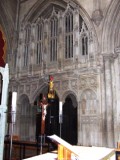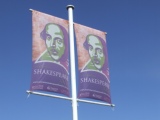 Death of Humphrey, Duke of Gloucester, aged 56. He was the youngest son of Henry IV, brother of Henry V and Lord Protector to his young nephew Henry VI, who was only nine months when he succeeded his father. Humphrey is buried at St Albans Cathedral.
Death of Humphrey, Duke of Gloucester, aged 56. He was the youngest son of Henry IV, brother of Henry V and Lord Protector to his young nephew Henry VI, who was only nine months when he succeeded his father. Humphrey is buried at St Albans Cathedral.
(Photograph of the Chantry of Humphrey of Gloucester in St Albans Cathedral © Dorothea Preis)
Tags: Hertfordshire, Humphrey of Gloucester, St Albans
Comments Off on 23 FEBRUARY 1447

St Michael’s Bridge and ford (© D Preis)
Second Battle of St Albans – a Lancastrian victory
The second Battle of St Albans was fought on 17 February 1461 between the Lancastrian forces under Margaret of Anjou (Henry VI’s queen) and the Yorkist forces under Richard Neville, Earl of Warwick (‘The Kingmaker”). It was won by the Lancastrian forces. Henry VI was reunited with his wife and son. The Yorkists, however, won the Battle of Towton on 29 March 1461 and with it the crown for Edwrad IV.
The photo shows St Michael’s Bridge and ford. Part of the Lancastrian forces led by Sir Andrew Trollope entered St Albans via this ford. The present bridge was only built in 1765, but it is considered to be the oldest still existing bridge in Hertfordshire.
The second Battle of St Albans was fought over a larger area than the first Battle of St Albans on 22 May 1455, which was concentrated on the streets in the town centre.
The website St Albans & Hertfordshire Architectural and Archaeological Society has a map showing the area covered by both battles.
A short description of the various battles of the Wars of the Roses can be found on the website of the Richard III Society.
Dorothea Preis
Tags: Hertfordshire, St Albans, Wars of the Roses, Yorkists

Ruins of Sopwell Nunnery, St Albans (© D Preis)
Marriage of Henry VIII and Anne Boleyn
On 25 January 1533, Henry VIII married Anne Boleyn in secret, possibly at Sopwell Nunnery in St Albans. This is suggested among others on the blog The Tangible Past.
Henry was very much attracted by Anne’s charm and wit. To be able to marry her, Henry wanted to divorce his first wife Katherine of Aragon, to whom he had been married for 24 years. This meant he also had to break with the Church of Rome, who did not accept his reasons for a divorce. Their marriage was only annulled on 23 May 1533, when Thomas Cranmer declared it null and void. On 28 May 1533 he declared the marriage of Henry VIII and Anne Boleyn valid.
However, as Anne did not produce the looked-for male heir, after approx. 1000 days of marriage, Henry ordered Anne’s execution.
You might find Suzannah Lipscomb‘s article on this marriage of interest.
Tags: Henry VIII, St Albans
Comments Off on Marriage of Henry VIII and Anne Boleyn

Market Place in St Albans, where the first battle was fought (© D Preis)
First Battle of St Albans – fighting on the market place
On 22 May 1455 the first Battle of St Albans, Hertfordshire, between the Yorkist forces under Richard, 3rd Duke of York, and the Lancastrian forces of Henry VI under Edmund, Duke of Somerset, who fell in the battle. Henry VI was captured. The battle was won by the Yorkists.
This is the first battle in what became known as the Wars of the Roses, with the white rose standing for York and the red for Lancaster (Henry VI). This battle is unique among all the battles of the Wars of the Roses in that it was entirely fought in the streets of the town and not in a field. Walking around the market area of St Albans today, you can still see the outline of the area in medieval times with its half-timbered houses and the narrow and winding alleyways. One can’t help wondering what the town’s citizens made of this. And not to forget that not even six years later on 17 February 1461, the armies were back for a second battle.
You can read more on the first Battle of St Albans on Karen’s blog and on Dottie Tales.
A short description of the various battles of the Wars of the Roses can be found on the website of the Richard III Society.
Dorothea Preis
Tags: Battles, St Albans
 The body of Eleanor of Castile , wife of Edward I, rested for one night at St Albans on her progress from Harby, where she had died on 28 November 1290, to Westminster. Her funeral took place on 17 December 1290 at Westminster.
The body of Eleanor of Castile , wife of Edward I, rested for one night at St Albans on her progress from Harby, where she had died on 28 November 1290, to Westminster. Her funeral took place on 17 December 1290 at Westminster.
The plaque in the picture can be found on the fifteenth century Clock Tower in St Albans, which is near the spot where the Eleanor Cross once stood. Originally there were twelve crosses at each of the overnight resting place of the procession for Eleanor’s body, but only three of them remain. Unfortunately the St Albans cross is not one of them, it was demolished in the early eighteenth century. It was located next to the Clock Tower and opposite from the Waxhouse Gateway to the Abbey precinct.
(Photograph © Dorothea Preis)
Tags: St Albans

Fighting in the Streets – The Battles of St Albans
People who know me, will have realised that I have a particular interest in St Albans and anything connected to the town or the saint.. After I had previously looked at the goings-on at the Abbey and its cells, I am planning to turn my attention to the civilian population in the middle ages. As the civilian population would have been very much at the receiving end of the two battles fought in their midst, irrespective of who won that battle, I recently read two books dealing with these battles. Read the rest of this entry »
Tags: Hertfordshire, St Albans
It is amazing how sometimes strands of seemingly unrelated interests come together. This happened when I was planning a trip to Europe for next year to attend the “Blood and Roses” Special Interest Weekend in Oxford in March, an event at Christ Church College in association with the Richard III Society. Afterwards I was thinking of spending a few days in Germany visiting sites of personal interest, after all I would be in the area, so to speak.
During my recent research into St Albans I had read that a church in Cologne is said to hold relics of St Alban.[1] At the time I didn’t pursue this any further, but now that a visit to Cologne is on the cards I decided to find out more. Read the rest of this entry »
Tags: Church, St Albans
Posted by: Dorothea Preis in News
 Last week my husband attended a conference in Hobart in Tasmania. So I went along for some sightseeing. Visiting St David’s Cathedral I admired the beautiful stained glass windows. One of them showed St Alban, which after my recent work on St Albans in Hertfordshire was like meeting an old friend.
Last week my husband attended a conference in Hobart in Tasmania. So I went along for some sightseeing. Visiting St David’s Cathedral I admired the beautiful stained glass windows. One of them showed St Alban, which after my recent work on St Albans in Hertfordshire was like meeting an old friend.
Saint Alban was the first martyr of Britain (executed in c. 304). His story has often been told, among others by the Venerable Bede.[1] According to this, Alban was a Romano-British citizen of Verulanium, who gave shelter to a Christian priest, called Amphibalus, during a persecution of Christians. He was so impressed by what this man had to say that Alban converted to Christianity. When Roman soldiers came to search his house for the priest, he pretended to be him and was arrested. During the trial he stood firm to his new faith and was beheaded.[2] However, en route to his execution he performed several miracles like stopping the water of the river to flow and causing a spring of water on the hill, where he was beheaded (hence the street name ‘Holywell Hill’). His original executioner converted to Christianity on the spot and the man who eventually did the deed was punished by blindness. Unfortunately all this did not help Amphibalus, who along with some others was a few days later stoned to death.[3]
 At the time we were there, the Australian Shakespeare Festival was taking place in Hobart. Unfortunately we did not have time to visit any of the vents, but William was looking down on us from a great height all over the city, which was like running into another old friend.
At the time we were there, the Australian Shakespeare Festival was taking place in Hobart. Unfortunately we did not have time to visit any of the vents, but William was looking down on us from a great height all over the city, which was like running into another old friend.
Notes:
1. “St Alban”, Catholic Encyclopedia – New Advent. (accessed 23 May 2010)
2. “The Story of St Alban”, The Cathedral and Abbey Church of St Alban. (accessed 24 May 2010)
3. “St Alban”, New Advent
Tags: Hertfordshire, Shakespeare, St Albans

St Albans – Hertfordshire
When considering which could be my next Ricardian Place in Hertfordshire, the recent 555th anniversary of the First Battle of St Albans (22 May 1455) offered the obvious answer. During our life in England St Albans was a popular haunt for us, for shopping, eating out or just soaking up the atmosphere. I also happened to have a number of private students there – hello to Tony and Jacky, should you read this.
There have been settlements in the St Albans area for a long time. The first that we know of was by the Celtic Catuvellauni tribe, who called it ‘Verlamion’. During the Roman period it became ‘Verulanium’, the second largest town in England after Londinium, situated on Watling Street heading north.[1] Most of the remains of the Roman town are today covered by Verulanium Park, but some parts have been excavated and can be visited. For instance the Hypocaust (including an in situ mosaic); the Roman Theatre of Verulamium; and the remains of the Roman city walls and London gate.[2] Read the rest of this entry »
Tags: Battles, Church, Hertfordshire, St Albans, Wars of the Roses, Yorkists









